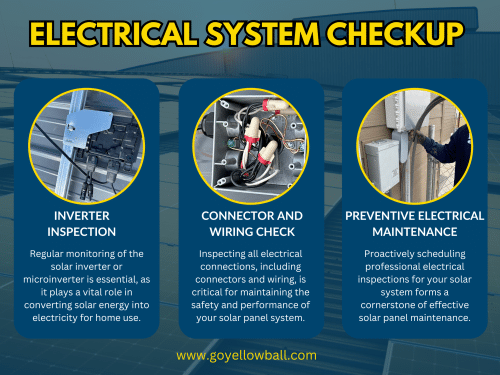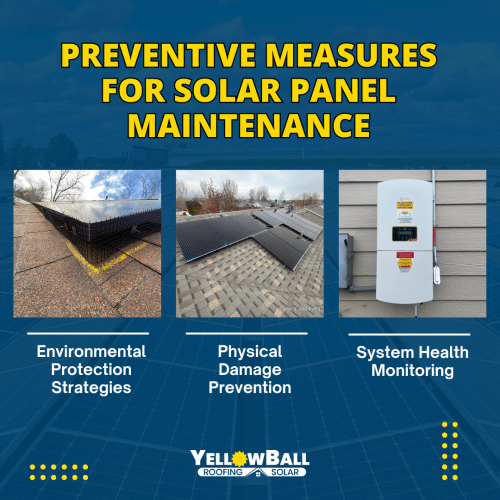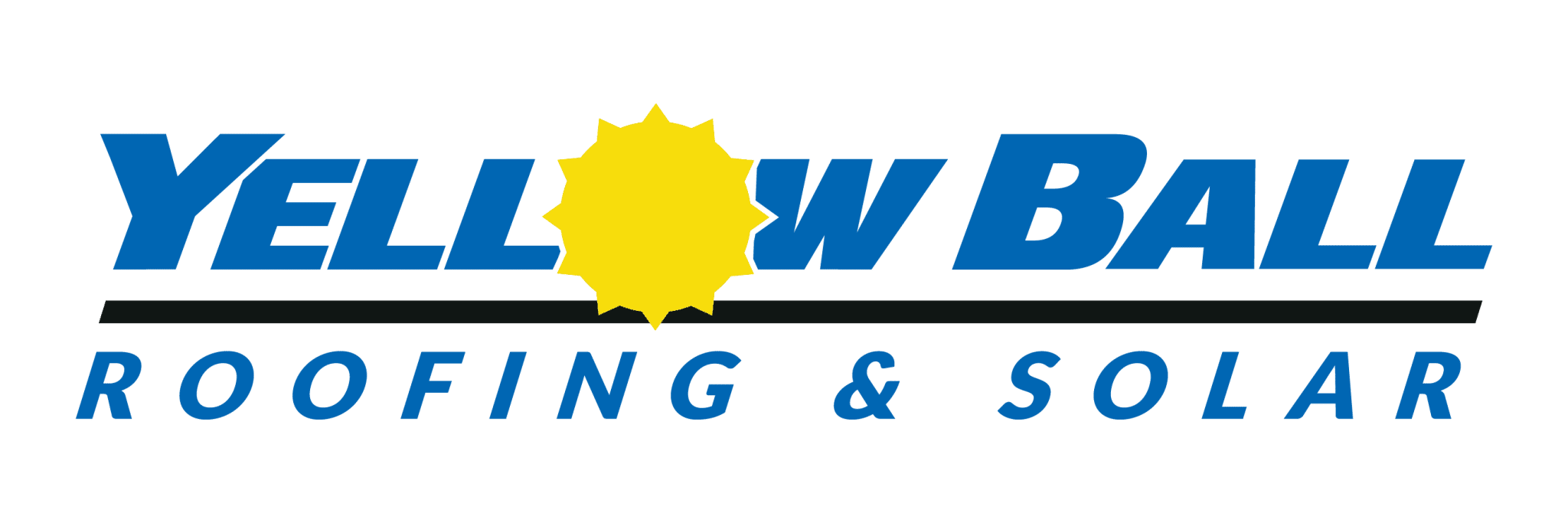Solar panels are a fantastic source of clean, renewable energy, but like any investment, they require proper care to operate at their best. This concise guide on the solar panel maintenance checklist is designed to help you enhance your system’s efficiency through routine upkeep.
Understanding the importance of maintenance is the first step in safeguarding the longevity and productivity of your solar panels.
We’ll guide you through preparing a solar panel maintenance checklist, conducting visual inspections to identify any issues, and employing the most effective cleaning methods to ensure your panels absorb maximum sunlight.
Additionally, this guide covers essential electrical system checks and strategies to prevent common operational problems, ensuring your setup remains robust against potential malfunctions.
We’ll also highlight the significance of troubleshooting emerging issues promptly and the benefits of maintaining a detailed log of your maintenance activities.
By following these straightforward steps, you can ensure your solar panels continue to deliver optimal performance, reducing energy costs and contributing to a healthier planet for years.
Ready to make your home a model of sustainability and efficiency? Contact YellowBall Roofing & Solar today and take the first step towards a greener, more cost-effective future.
Table Of Contents:
- Understanding Solar Panel Maintenance
- Initial Steps in Solar Panel Maintenance
- Visual Inspection for Solar Panel Maintenance Checklist
- Cleaning Techniques for Solar Panels
- Electrical System Checkup
- Preventive Measures for Solar Panel Maintenance
- Troubleshooting Common Solar Panel Issues
- Documenting Your Maintenance Journey
- FAQs about the Solar Panel Maintenance Checklist
- What should I look for during a visual inspection of my solar panels?
- How often should I clean my solar panels?
- What is a PV junction box, and why is it important in solar panel maintenance?
- Can regular maintenance help reduce my overall maintenance costs for solar panels?
- What safety hazards should I be aware of when maintaining solar panels?
- Maximizing Solar Efficiency: A Conclusion on Solar Panel Maintenance Checklist
Understanding Solar Panel Maintenance
Maintaining your solar panel system is crucial for ensuring its longevity and efficiency. At Yellowball Roofing & Solar, we understand the unique challenges homeowners in Montana and Wyoming face regarding sustainable living.
That’s why we’ve compiled a comprehensive maintenance checklist explicitly tailored for you. Let’s explore how to keep your solar power system running smoothly all year round.
Regular Inspection and Cleaning
The first step in maintaining your solar panels is conducting regular inspections and cleanings. Over time, dust, snow, leaves, or bird droppings can accumulate on the panels’ surface, potentially reducing their efficiency by blocking sunlight.
We recommend inspecting your panels at least twice yearly to ensure they are debris-free. Those living in areas with heavy snowfall, like Montana and Wyoming, should consider increasing these checks during winter.
Common Myths about Solar Panel Maintenance
Many believe solar panels are ‘set and forget’ systems. However, while they are low-maintenance, they are not non-maintenance. Having a maintenance routine like cleaning and inspections is necessary to ensure the peak performance of your solar power system.
Another myth is that rain cleans solar panels sufficiently, which is not always the case, especially in areas with low rainfall or high dust levels.
Initial Steps in Solar Panel Maintenance
Prioritize Safety First
Before undertaking any maintenance tasks, prioritize safety by turning off your solar system, wearing protective gear, and ensuring you’re properly trained or consulting with professionals if in doubt.
- Dress appropriately: Wear anti-slip footwear, gloves, and protective eyewear without compromise.
- Secure your ladder: Make sure it’s stable and secure before climbing up to the roof.
- Disconnect Power: Before touching anything within the range of your solar power system, shut off your system’s power to avoid shocks or accidents.
Gather Your Toolkit
Prepare tools such as soft brushes, squeegees, and appropriate cleaning solutions. If your panels are installed in hard-to-reach areas, ensure you have a stable ladder and safety harness.
Planning Your Maintenance Schedule
Create maintenance guidelines that include visual inspections every six months and more thorough check-ups annually.
Adjust the frequency based on your local environment, with more frequent cleaning in dusty or bird-populated areas.
Visual Inspection for Solar Panel Maintenance Checklist
Check for Physical Damage
Examine your solar panels for signs of physical damage, such as cracks, scratches, or dents. Harsh weather conditions can impact their structural integrity.
If you notice any damage, it’s crucial to contact professional repair services or your local solar company like YellowBall Roofing & Solar immediately to prevent further issues.
Cleanliness of Panels
Snow, dust, leaves, and bird droppings can accumulate on your panels over time, obstructing sunlight and reducing efficiency. We recommend using a soft brush or cloth to gently clean the surface of your panels regularly.
For more stubborn grime or during heavy snowfall periods in Montana and Wyoming, specialized snow removal services can be invaluable.
Inspect Mounting Equipment
The stability of your solar panel system largely depends on its mounting equipment. Ensure that all mounts are securely fastened and free from rust or corrosion—two common issues that could compromise the safety and performance of your setup.
Loose fittings of bolts of your solar panels can lead to misalignment, or in the worst-case scenario, panels will be detached.
Cleaning Techniques for Solar Panels
General Cleaning Guidelines
To maintain solar panel efficiency, use a soft brush or cloth paired with lukewarm water for gentle cleaning. Avoid using harsh detergents or abrasive tools that could scratch or damage the panel’s surface.
This method removes most surface dirt and dust without compromising the integrity of the panels. Ensuring that the cleaning process is both effective and gentle helps prolong the panels’ lifespan and properly maintain their efficiency.
Regular cleaning, following these guidelines, can significantly enhance solar panel performance and energy output.
Dealing with Stubborn Stains and Residues
When faced with stubborn stains such as bird droppings or tree sap, use a mild, soapy water solution as a cleaning agent. Apply the solution gently to the affected areas and allow it to soak briefly to loosen the debris before rinsing thoroughly with water.
Don’t use sharp or metal tools because they can permanently scratch the solar panel. If a stain is really tough, you might need to clean it more than once. But remember, being gentle and patient when cleaning solar panels will preserve their efficiency.
This approach ensures that even the most persistent residues can be removed safely, maintaining the aesthetic and functional quality of your solar panels.
Cleaning Frequency and Timing
Determining the optimal cleaning frequency for solar panels will depend on your local environment. In areas prone to dust, pollen, or frequent bird activity, cleaning may be needed more regularly, potentially every 3-6 months.
In contrast, a 6-12 month cleaning interval may suffice in cleaner, less exposed areas. Cleaning should be done in the early morning or late afternoon to reduce the chance of thermal shock from temperature variations on the panels.
Adhering to a strategic cleaning schedule maximizes panel efficiency and longevity, ensuring that your solar investment continues to yield high returns.
Electrical System Checkup
Inverter Inspection
Regular monitoring of the solar inverter or microinverter is essential, as it plays a vital role in converting solar energy into electricity for home use. Look for any error messages or alerts on the inverter display or application that can indicate malfunctions needing immediate attention.
 Ensuring the inverter is functioning correctly can significantly impact the overall efficiency and reliability of your solar power system. Regular inspections can help identify potential issues before they escalate, saving time and money on extensive repairs.
Ensuring the inverter is functioning correctly can significantly impact the overall efficiency and reliability of your solar power system. Regular inspections can help identify potential issues before they escalate, saving time and money on extensive repairs.
A well-maintained inverter ensures optimal conversion rates, maximizing the energy you draw from your solar panels.
Connector and Wiring Check
Inspecting all electrical connections, including connectors and wiring, is critical for maintaining the safety and performance of your solar panel system. Look for signs of wear, corrosion, or looseness, as these can impair the system’s efficiency and increase the risk of electrical hazards.
Ensuring secure and corrosion-free connections helps maintain uninterrupted power flow from the panels to your home or grid. Regular checks allow for timely repairs or replacements, preventing potential system failures.
This solar maintenance step is essential for preserving the long-term health and efficiency of your solar energy system.
Preventive Electrical Maintenance
Proactively scheduling professional electrical inspections for your solar system forms a cornerstone of effective solar panel maintenance. These annual check-ups ensure that all components, especially those related to electrical connectivity, are in optimal working condition.
Experts can spot problems that aren’t obvious to everyone. This approach safeguards the system’s performance and extends its lifespan by addressing small issues before they become significant.
Embracing preventive electrical maintenance is a wise investment in the reliability and efficiency of your solar energy system.
Preventive Measures for Solar Panel Maintenance
Environmental Protection Strategies
Installing protective barriers or mesh around your solar panels can prevent birds from nesting underneath, preserving the panels’ integrity and performance.
In regions prone to heavy snowfall, it’s crucial to verify that your mounting system is robust enough to withstand the weight of accumulated snow, preventing potential structural damage.
These strategies not only protect your solar panels from environmental threats but also ensure consistent energy production throughout the year. By mitigating risks from wildlife and natural elements, you can extend the lifespan and efficiency of your solar power system.
 Physical Damage Prevention
Physical Damage Prevention
To prevent physical damage, avoid walking on solar panels and shield them from falling debris or objects. Regular checks for and removal of materials that could exert unnecessary pressure or cause scratches are essential for maintaining panel efficiency.
By taking these precautions, you can ensure that your solar panels maintain their structural and operational quality and continue to perform for the duration of their anticipated life.
You can safeguard your investment and maintain optimal energy production by minimizing physical risks.
System Health Monitoring
Leveraging system monitoring tools available with most solar installations is critical to maintaining optimal performance.
These tools enable you to track your system’s output and identify any discrepancies in energy production, signaling potential maintenance needs.
Regular monitoring can detect issues early, allowing swift interventions to prevent more significant problems later. This proactive approach to system health ensures your solar panels operate efficiently, maximizing renewable energy benefits.
Troubleshooting Common Solar Panel Issues
Inverter Failure Symptoms and Solutions
Watch for warning lights or messages on your inverter that show something is wrong. Updating the inverter’s software and getting it checked by experts like YellowBall Roofing & Solar can help stop common problems.
If the inverter doesn’t work right, it can’t change sunlight into electricity properly. Fixing these issues quickly ensures your solar system keeps working well.
Dealing with Reduced Power Output
If your solar panels produce less electricity, look for shadows, dirt, or other problems with your equipment. Cleaning the panels or fixing the issues can help restore the power level.
Sometimes, simple fixes can significantly affect how much electricity your panels produce. Keeping the panels clean and clear from shadows helps them work better.
Addressing Shading and Obstruction Issues
Check around your solar panels now and then for new shadows from growing trees or buildings. You might need to cut branches or move your panels to get them back into full sunlight.
Ensuring your panels get enough sun is key to getting the most power from them. Keeping the area around your solar panels clear can help you avoid these shadow problems.
Documenting Your Maintenance Journey
Creating a Maintenance Log
Write down every time you check or fix your solar panels, including what you found and did about it. Also, note when you get help from experts. This log helps you keep track of how your solar system is doing.
Over time, you can see how well your panels work and remember when you last did maintenance. Keeping good records makes it easier to take care of your solar panels.
The Value of a Detailed Maintenance Record
Having a complete record of your solar panel care is very useful. If there’s a problem while they’re still under warranty, your log can help prove you’ve been taking good care of them.
It also helps you figure out problems faster if something goes wrong. If you ever want to sell your house, showing buyers your maintenance log can make your solar system more attractive.
Good records show that your solar panels have been well looked after.
Leveraging Maintenance Records for System Improvement
Look at your maintenance records to spot patterns, like the same problem happening repeatedly or the system not working as well as it used to.
This information can help you decide if you need to upgrade parts of your system or change how you care for it. Knowing what’s been happening with your solar panels can help you make them work better.
Using your log can make your solar panels last longer and work more efficiently. Keeping track of everything helps you improve your solar panel system in the long run.
FAQs about the Solar Panel Maintenance Checklist
What should I look for during a visual inspection of my solar panels?
Check for any damage to the solar cells, such as cracks or discoloration.
How often should I clean my solar panels?
Clean your solar panels at least twice a year to ensure optimal performance.
What is a PV junction box, and why is it important in solar panel maintenance?
A PV junction box is part of your solar panel that houses electrical connections; checking it is vital for preventing electrical issues.
Can regular maintenance help reduce my overall maintenance costs for solar panels?
Yes, regular maintenance can identify and fix small issues before they become big, expensive problems.
What safety hazards should I be aware of when maintaining solar panels?
Be cautious of electric shock or falling from heights, and always prioritize safety.
Maximizing Solar Efficiency: A Conclusion on Solar Panel Maintenance Checklist
Using a solar panel maintenance checklist is vital to keeping your solar energy system working well and lasting long. Regular checks, cleanings, and fixing any issues quickly help your panels get more sunlight.
Also, monitoring the electrical parts and avoiding common problems will ensure your solar energy system stays strong and reliable.
Staying on top of these tasks will ensure that your solar panels perform at their best, saving you money and helping the planet.
This guide gives you the know-how to keep your solar panels in top shape, showing how important regular maintenance is for better energy use and environmental support.
Contact YellowBall Roofing & Solar for innovative solutions to make your home more energy-efficient. Your journey towards a sustainable home starts here.




